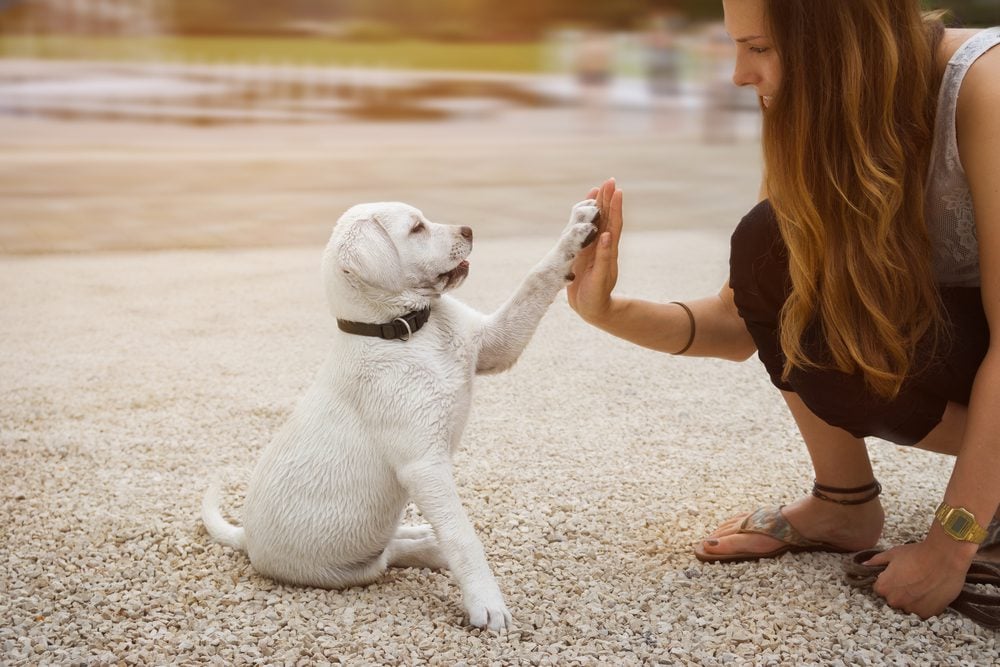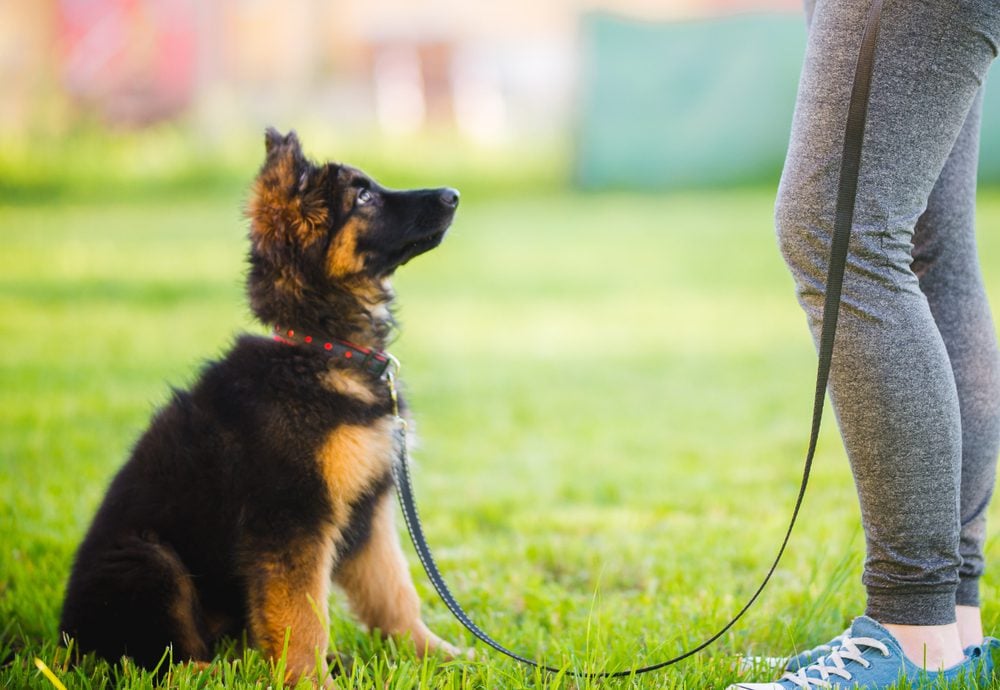Obedience training is necessary for any puppy to become a well-mannered adult dog, but it’s especially important if you’re hoping your pup can become a service dog. Service dogs are taken into many different settings where companion dogs aren’t allowed, so it’s vital that they are well-behaved and obedient.
Obedience training doesn’t happen overnight, though. Your puppy is going to be curious and rambunctious, so teaching them which behaviors are acceptable and which aren’t is a process. This process is one you can undertake alone or with an experienced dog trainer, and we’ll talk about the pros and cons of each.
Whether you train your dog yourself or with the help of a trainer, you must use the right training methods and rewards. You also cannot forget socialization and handling; these aren’t typically thought of as obedience training, but they’re very important to raising a well-behaved dog.
They’re just as vital to your pup’s training as actual commands, which we’ll also be sharing. While your dog will learn several skills over time, there are five basic commands that we feel are most important to teach puppies. Along with these, we’ll help you troubleshoot some common behavior issues. This article will cover everything you need to know to successfully obedience train your puppy.
Should You Hire a Trainer or Do It Yourself?
When it comes to training your dog, you have a few options. Each one has its pros and cons. First, you have to decide whether you’d like to work with a trainer or train your dog yourself. Working with a trainer can sometimes be expensive, but it means you have an expert who can help you successfully train your dog the skills you’re interested in.
It is possible to train a dog by yourself without hiring a trainer. One of the main benefits of this is that it is cost-efficient; it isn’t uncommon to spend hundreds of dollars on dog trainers. You can also train on your schedule; this is great for people who have unpredictable schedules and can’t make it to classes every week.
Of course, training by yourself means you have no one to ask questions to if you get stuck. You’ll also have to find opportunities for your dog to meet other dogs and people, which is a lot easier if you attend group training classes.
Try a Trainer
If you hire a trainer you’ll have someone to keep you accountable; sometimes, when we have no one to answer to, we get lazy and skip dog training more nights than we should. Not only will you want to meet your trainer’s expectations, but you won’t want to waste money, so you’ll be more likely to work on your dog’s training at home.
If you don’t have much experience with training dogs, then it’s best to hire a trainer or attend training classes. Making mistakes can hinder your dog’s learning and even result in unwanted behaviors.
Speaking of training classes, let’s discuss the different options available to you if you do decide to work with a dog trainer.
What Kind of Dog Training Should I Choose?



When it comes to working with trainers, there are usually a few different options available. Some trainers will come to your home to work with you, others host group classes, and some offer packages of both. Once again, there are pros and cons to each approach.
One-On-One Training
Trainers that work with you in your home are a convenient option, as they give you and your dog 100% of their attention. This makes it easy to focus only on the skills you want your dog to learn. Sometimes, group classes may teach skills you’re not particularly interested in.
Group Classes
Group classes provide much less one-on-one attention, but they teach your dog how to listen and behave around distractions. They also allow your dog to socialize with different dogs and people. Many rescue organizations like the Humane Society offer group classes at reasonable prices.
Some trainers offer the best of both worlds. They give you a number of one-on-one courses with group training stitched in between. This allows you to focus on specific skills during private lessons but still teach your dog to behave amid distractions during group lessons.
Dog Boarding School
You can also choose to send your dog to boarding school. Your dog will live with the trainer for some months and learn proper behavior as well as any skills you wish for your dog to learn. While this type of training often results in very obedient dogs because they’ve been trained by experts from day one, the downside is that you don’t get to be a part of your puppy’s life during this time.
Boarding is a great option if you struggle to find time to train your dog yourself. However, once they are returned to you fully trained, you should continue practicing the skills your pup learned at the boarding school. As the saying goes, “if you don’t use it, you lose it.” This is true for dogs, too.
Choosing the Right Trainer
If you’ve decided that working with a trainer is the best option for you, then you need to pick the right one. Nothing feels worse than spending hundreds of dollars on training that is ineffective, or worse, inhumane. This is why you should research any trainer or classes you’re interested in.
See if there are any reviews online; many trainers and schools have Facebook pages where clients leave reviews. You should also call and ask questions about what training methods they use and what equipment is needed, if any.
Don’t be afraid to sit in on a training session, if possible. This will show you exactly what the trainer is about, how effective their methods are, and how they troubleshoot things like behavior problems.
The Best Training Methods Are Force-Free



Regardless of whether you train your dog yourself or pay a trainer, the methods used are incredibly important. The best methods for training dogs are entirely force-free. This means no choke chains or prong collars, no shock collars, no hitting, and no alpha-rollovers.
Training a dog with force will damage your relationship and will only teach your dog to fear you. In worst-case scenarios, your dog may even react aggressively in defense. Would you rather your dog listen to you because she’s afraid of getting hit or because she finds listening to you to be fun and rewarding? This is the difference between forceful and force-free training.
Force-free training is an umbrella term for any type of training that doesn’t require force. However, the most prominent is positive reinforcement training. This type of training hinges on rewarding your dog for doing something right and withholding rewards or even ignoring your dog for incorrect actions.
Positive reinforcement creates an association in the dog’s brain that listening to you is fun and rewarding, which in turn makes your dog more motivated to listen to you in the future.
Consider Clicker Training
While many trainers use rewards and praise as their main tool for teaching dogs, another popular mode of positive reinforcement training is clicker training. For this, you use a device called a clicker that makes a unique clicking sound. The clicker is used to mark the exact moment your dog performs the behavior you were looking for.
By pairing the sound of the clicker with a reward, a dog can understand exactly what behavior results in said reward. Of course, you must click at the exact moment that your dog performs the desired action. The precision with which you can mark behaviors is the reason that clicker training is so effective and thus a favorite method of many trainers.
Choosing the Right Reward
The rewards you use are just as important as the method. If your dog is not motivated by what you have to offer, then you’re not going to get very far. Any trainer you work with should understand this and be flexible with rewards.
Most dogs fall into two categories, however: food-motivated and play-motivated. Food-motivated dogs are some of the easiest to train because they will do anything for a treat. However, you should still vary the treats you use to keep things interesting and exciting for your pup. Play-motivated dogs can be a bit more challenging at first, but once you understand what type of toys they love, you’ll have an easier time.
For these dogs, It’s also helpful to keep a few special toys that are used only for training. Dogs do lose interest in their toys. When you manage this resource and make it something they only have access to for a short amount of time, it becomes more desirable and exciting. Having a few special training toys is better as you can rotate them and avoid having your dog grow bored of you always using the same one.
Teaching Walking Skills
Rewarding your dog is all about understanding what motivates them. If you take your dog for a walk but you have no treats or toys, you can still teach them to walk nicely by using their motivation to your advantage.
Dogs who are walking want to keep moving in a certain direction, so you can stop or even turn around if the dog pulls. Basically, your dog will learn that as long as the leash is loose you keep moving; if it goes taut, then you either stop moving or move away from your dog’s desire.
Choosing the right reward for your pet requires you to ask yourself what your dog wants and decide if you can give it to them as a reward for good behavior. Sometimes, you can’t — we don’t want our dog chasing the squirrel they’re pulling toward — but many times, as is the case with treats, toys, and moving forward during a walk, you can.
Socialization and Handling
A training course that’s worth your money will also cover handling and socialization. The first three months of your dog’s life are a critical period. During this time, your dog can learn to habituate sights, sounds, people, and other animals. These things will become normal to them as long as they aren’t paired with anything negative.
This is why it is a must to get your dog used to as many different types of people as possible. You’ll also want to take them to different places to expose them to different settings.
Although socialization will continue to occur until the dog is about a year old, the first three months are the most critical time. After these three months, your dog is far more likely to respond to stimuli they have never encountered before with fear. During these three months, however, you can think of your dog as far more curious and open-minded.
You can almost consider handling a type of socialization because you are doing it to get your dog used to certain sensations. For instance, you’ll want to touch and pick up your dog’s feet to get them used to this process since you will have to cut their nails in the future. You’ll also want to practice trimming the nails.
Make Sure They’re Clean and Happy
Other important handling includes checking and brushing the teeth as well as grooming and bathing the dog’s fur. Any tool you plan to use on your dog, whether it be shears or a nail grinder, needs to be used on them within the same three-month period mentioned. Otherwise, you’ll have a hard time with things in the future.
Handling your dog is so important for making trips to the vet or the groomer as painless as possible (for both the professional and your dog). Some groomers will even charge less for well-behaved dogs because they do not need help from an assistant.
The Five Most Important Basic Obedience Skills



Now that you have a better understanding of the options you have for dog training and the best methods you can use, let’s talk about what you should be teaching your dog. We’ll explain why these commands are so important.
Sit
“Sit” is one of the easiest commands for a dog to learn, which is why it’s often the first command many pups learn. It’s also a very helpful skill for your dog to have. It can be used to put your dog in a calm position and is also great for times when you want a little personal space (we’re guilty of letting our dogs beg, and “sit” is a must for these moments).
Come
The “come” command is possibly the most important command for your dog to learn. A strong come recall can save your dog’s life. Imagine your dog is chasing a ball or a squirrel and is going to run into a busy street. If you call “come” and your dog immediately obeys the command, they are no longer in danger.
Having a dog that comes reliably also makes it more likely that the dog can be trusted off-leash in appropriate areas. A dog who can be off-leash is a joy to have, especially if you enjoy outdoor activities like hiking or swimming.
Stay
Stay is another very useful command that can be used in a variety of situations. For instance, let’s say there’s some sort of mess in your house that needs to be cleaned immediately, and you don’t want the dog walking through it. A dog who has mastered this command will stay in place until you’re finished cleaning.
Leave It
“Leave it” is another command that could potentially be lifesaving. Unfortunately, people litter, and there have even been cases of people purposefully leaving out items that are dangerous for dogs. If you spot something that your dog is interested in, but you don’t want them picking up or eating, you can use the “leave it” command so your dog will leave it alone.
Much like the come command, “leave it” can also be used to get your dog to stop running after something. The difference is that “leave it” only asks your dog to stop chasing rather than to run back to you. Still, this can also be lifesaving (for both your dog and the animal they were about to catch).
Drop It
Even if your dog knows the “leave it” command, there will be times that they pick up things you don’t want them to have. Sometimes, you’re unable to use “leave it” because you didn’t see the item before your dog did. In these cases, you can teach your dog the “drop it” command so they’ll spit out whatever they’ve got.
Some people like to use the word “give” instead, and either command can be trained so that your dog drops things directly into your hand. This is great if your dog loves playing fetch but you hate constantly bending over to pick up their ball.
Common Behavior Issues
As you work on obedience training you may see your dog developing some behaviors you aren’t happy with. This is very common and is often a result of the dog’s excitement or curiosity. Some common behavior issues include jumping, counter surfing, and garbage raiding.
Jumping
Jumping typically happens when your dog is excited about you or your guests entering the house. Many people default to telling their dogs “no,” but dogs are much better at learning what they should do than what they shouldn’t do.
Therefore, it’s best to teach your dog an appropriate behavior that they should do in situations that excite them. You can teach the command “off” and ignore your dog for jumping by turning your back. Do not offer any attention until all four paws are on the floor. You can also use “sit” or “down” to teach your puppy to sit calmly when people arrive.
Counter Surfing and Garbage Raiding
Counter surfing and garbage raiding can be more difficult to address if your dog is able to take something from these areas; they get rewarded with whatever they steal (usually food). Commands like “off” and “leave it” can be helpful in these situations, but prevention is even better.
If you keep your dog from discovering the delicious things in the garbage, then it’ll be easier to teach them to stay away from the garbage. We suggest keeping your puppy tethered to you or always in the same room. Giving a young puppy too much freedom gives them too many opportunities to get into things they shouldn’t and develop bad habits.
You should also invest in a garbage can with a latching lid; dogs can easily nose open the lid on step-on garbages. Similarly, don’t leave food out on the counter. It is an unnecessary temptation for your puppy.
Obedience Training Is for Every Puppy



Every puppy needs obedience training to become a well-mannered member of the family. Obedience is even more important for puppies that will become service dogs as they need to behave in many different settings.
In terms of who trains your dog and where they are trained, you have a few options. You can either work with a trainer or do it yourself. Trainers may offer one-on-one lessons, group classes, or even boarding.
Hiring a trainer is valuable because they are experts who have worked with a number of dogs on many different behavioral skills. Of course, doing the training all by yourself means you save a lot of money, but there may be some skills you struggle with depending on how experienced you are.
Regardless of what you choose, the best methods for training dogs are force-free. Using force with your dog can result in fear and even aggression and will only serve to damage the bond between you and your furbaby. Focus on positive-reinforcement-based training instead. While basic obedience commands are important, don’t forget to work on socialization and handling, too.
